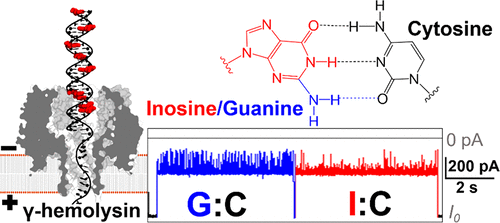当前位置:
X-MOL 学术
›
J. Am. Chem. Soc.
›
论文详情
Our official English website, www.x-mol.net, welcomes your
feedback! (Note: you will need to create a separate account there.)
γ-Hemolysin Nanopore is Sensitive to Guanine-to-Inosine Substitutions in Double-Stranded DNA at the Single-Molecule Level.
Journal of the American Chemical Society ( IF 14.4 ) Pub Date : 2018-09-30 , DOI: 10.1021/jacs.8b08153 Cherie S. Tan 1 , Aaron M. Fleming 1 , Hang Ren 1 , Cynthia J. Burrows 1 , Henry S. White 1
Journal of the American Chemical Society ( IF 14.4 ) Pub Date : 2018-09-30 , DOI: 10.1021/jacs.8b08153 Cherie S. Tan 1 , Aaron M. Fleming 1 , Hang Ren 1 , Cynthia J. Burrows 1 , Henry S. White 1
Affiliation

|
Biological nanopores provide a unique single-molecule sensing platform to detect target molecules based on their specific electrical signatures. The γ-hemolysin (γ-HL) protein produced by Staphylococcus aureus is able to assemble into an octamer nanopore with a ∼2.3 nm diameter β-barrel. Herein, we demonstrate the first application of γ-HL nanopore for DNA structural analysis. To optimize conditions for ion-channel recording, the properties of the γ-HL pore (e.g., conductance, voltage-dependent gating, and ion-selectivity) were characterized at different pH, temperature, and electrolyte concentrations. The optimal condition for DNA analysis using γ-HL corresponds to 3 M KCl, pH 5, and T = 20 °C. The γ-HL protein nanopore is able to translocate dsDNA at about ∼20 bp/ms, and the unique current-signature of captured dsDNA can directly distinguish guanine-to-inosine substitutions at the single-molecule level with ∼99% accuracy. The slow dsDNA threading and translocation processes indicate this wild-type γ-HL channel has potential to detect other base modifications in dsDNA.
中文翻译:

γ-溶血素纳米孔在单分子水平对双链 DNA 中鸟嘌呤到肌苷的取代敏感。
生物纳米孔提供了一个独特的单分子传感平台,可根据目标分子的特定电信号检测目标分子。由金黄色葡萄球菌产生的 γ-溶血素 (γ-HL) 蛋白能够组装成具有约 2.3 nm 直径 β-桶的八聚体纳米孔。在此,我们展示了 γ-HL 纳米孔在 DNA 结构分析中的首次应用。为了优化离子通道记录的条件,γ-HL 孔的特性(例如,电导、电压相关门控和离子选择性)在不同的 pH 值、温度和电解质浓度下进行了表征。使用 γ-HL 进行 DNA 分析的最佳条件对应于 3 M KCl、pH 5 和 T = 20 °C。γ-HL 蛋白纳米孔能够以约 20 bp/ms 的速度转移 dsDNA,并且捕获的 dsDNA 的独特电流特征可以在单分子水平直接区分鸟嘌呤到肌苷的替代,准确率约为 99%。缓慢的 dsDNA 穿线和易位过程表明这种野生型 γ-HL 通道具有检测 dsDNA 中其他碱基修饰的潜力。
更新日期:2018-09-30
中文翻译:

γ-溶血素纳米孔在单分子水平对双链 DNA 中鸟嘌呤到肌苷的取代敏感。
生物纳米孔提供了一个独特的单分子传感平台,可根据目标分子的特定电信号检测目标分子。由金黄色葡萄球菌产生的 γ-溶血素 (γ-HL) 蛋白能够组装成具有约 2.3 nm 直径 β-桶的八聚体纳米孔。在此,我们展示了 γ-HL 纳米孔在 DNA 结构分析中的首次应用。为了优化离子通道记录的条件,γ-HL 孔的特性(例如,电导、电压相关门控和离子选择性)在不同的 pH 值、温度和电解质浓度下进行了表征。使用 γ-HL 进行 DNA 分析的最佳条件对应于 3 M KCl、pH 5 和 T = 20 °C。γ-HL 蛋白纳米孔能够以约 20 bp/ms 的速度转移 dsDNA,并且捕获的 dsDNA 的独特电流特征可以在单分子水平直接区分鸟嘌呤到肌苷的替代,准确率约为 99%。缓慢的 dsDNA 穿线和易位过程表明这种野生型 γ-HL 通道具有检测 dsDNA 中其他碱基修饰的潜力。











































 京公网安备 11010802027423号
京公网安备 11010802027423号